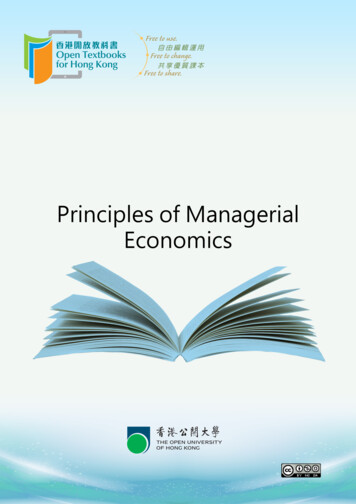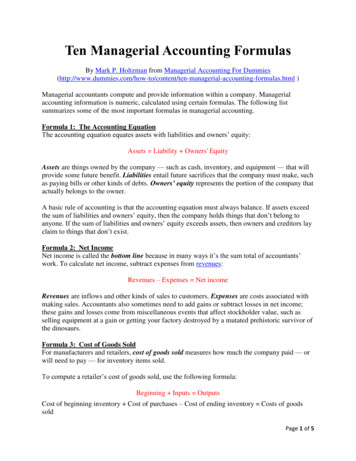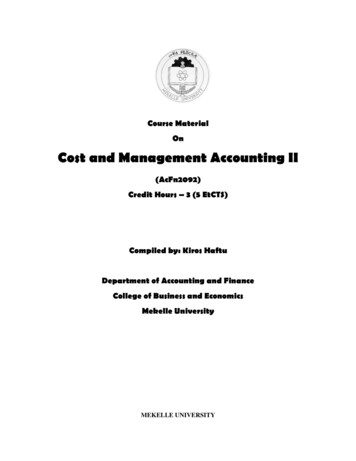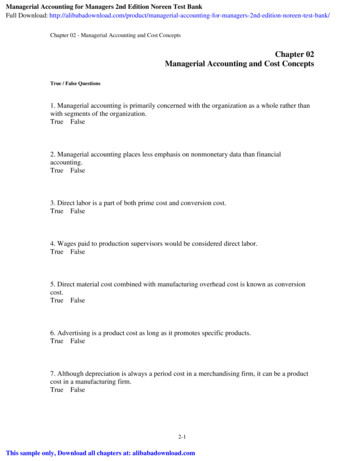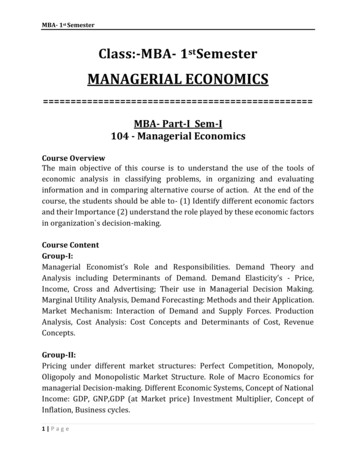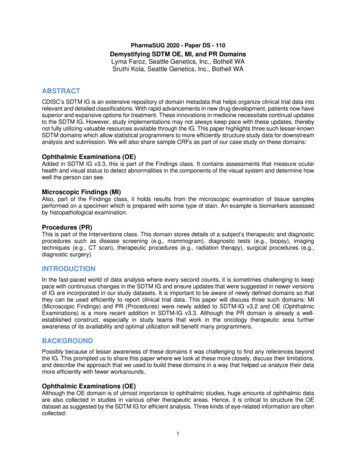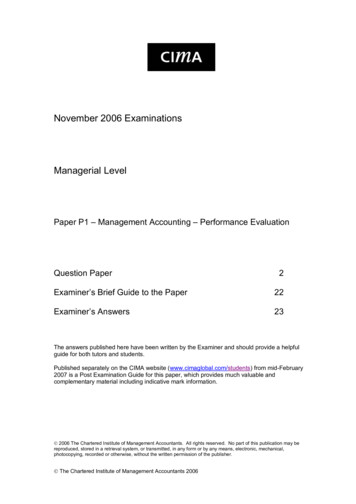
Transcription
November 2006 ExaminationsManagerial LevelPaper P1 – Management Accounting – Performance EvaluationQuestion Paper2Examiner’s Brief Guide to the Paper22Examiner’s Answers23The answers published here have been written by the Examiner and should provide a helpfulguide for both tutors and students.Published separately on the CIMA website (www.cimaglobal.com/students) from mid-February2007 is a Post Examination Guide for this paper, which provides much valuable andcomplementary material including indicative mark information. 2006 The Chartered Institute of Management Accountants. All rights reserved. No part of this publication may bereproduced, stored in a retrieval system, or transmitted, in any form or by any means, electronic, mechanical,photocopying, recorded or otherwise, without the written permission of the publisher. The Chartered Institute of Management Accountants 2006
Managerial Level PaperP1 – Management Accounting –Performance Evaluation21 November 2006 – Tuesday Morning SessionInstructions to candidatesYou are allowed three hours to answer this question paper.You are allowed 20 minutes reading time before the examination beginsduring which you should read the question paper, and if you wish, makeannotations on the question paper. However, you will not be allowed, underany circumstances, to open the answer book and start writing or use yourcalculator during this reading time.You are strongly advised to carefully read ALL the question requirementsbefore attempting the question concerned (that is, all parts and/or subquestions). The requirements for the questions in Section C are contained ina dotted box.Answer the ONE compulsory question in Section A. This has 18 subquestions and is on pages 2 to 10.Answer ALL SIX compulsory sub-questions in Section B on pages 11 and 12.Answer ONE of the two questions in Section C on pages 13 to 15.Maths Tables and Formulae are provided on pages 16 to 20.Write your full examination number, paper number and the examinationsubject title in the spaces provided on the front of the examination answerbook. Also write your contact ID and name in the space provided in the righthand margin and seal to close.P1 – Performance EvaluationManagement Accounting PillarTick the appropriate boxes on the front of the answer book to indicate whichquestions you have answered.P12November 2006
SECTION A – 50 MARKS[the indicative time for answering this section is 90 minutes]ANSWER ALL EIGHTEEN SUB-QUESTIONSInstructions for answering Section A:The answers to the eighteen sub-questions in Section A should ALL be written inyour answer book.Your answers should be clearly numbered with the sub-question number then ruledoff, so that the markers know which sub-question you are answering. For multiplechoice questions, you need only write the sub-question number and the letterof the answer option you have chosen. You do not need to start a new page foreach sub-question.For sub-questions 1.11 to 1.18 you should show your workings as marks areavailable for the method you use to answer these sub-questions.Question OneThe following data are given for sub-questions 1.1 to 1.3 belowA company uses standard absorption costing. The following information was recorded by thecompany for October:Output and sales (units)Selling price per unitVariable cost per unitTotal fixed overheads1.1The sales price variance for October wasA 38,500 favourableB 41,000 favourableC 41,000 adverseD 65,600 adverseBudget8,700 26 10 34,800Actual8,200 31 10 37,000(2 marks)November 20063P1
1.2The sales volume profit variance for October wasA 6,000 adverseB 6,000 favourableC 8,000 adverseD 8,000 favourable(2 marks)1.3The fixed overhead volume variance for October wasA 2,000 adverseB 2,200 adverseC 2,200 favourableD 4,200 adverse(2 marks)1.4A master budget comprises theAbudgeted income statement and budgeted cash flow only.Bbudgeted income statement and budgeted balance sheet only.Cbudgeted income statement and budgeted capital expenditure only.Dbudgeted income statement, budgeted balance sheet and budgeted cash flow only.(2 marks)P14November 2006
The following data are given for sub-questions 1.5 and 1.6 belowThe annual operating statement for a company is shown below: 0008003904109020300Sales revenueLess variable costsContributionLess fixed costsLess depreciationNet incomeAssets 6·75mThe cost of capital is 13% per annum.1.5The return on investment (ROI) for the company is closest toA4·44%B4·74%C5·77%D6·07%(2 marks)1.6The residual income (RI) for the company is closest to 000A(467)B(487)C(557)D(577)(2 marks)November 20065P1
1.7A company has reported annual operating profits for the year of 89·2m after charging 9·6m for the full development costs of a new product that is expected to last for thecurrent year and two further years. The cost of capital is 13% per annum. The balancesheet for the company shows fixed assets with a historical cost of 120m. A note to thebalance sheet estimates that the replacement cost of these fixed assets at the beginningof the year is 168m. The assets have been depreciated at 20% per year.The company has a working capital of 27·2m.Ignore the effects of taxation.The Economic Value Added (EVA) of the company is closest toA 64·16mB 70·56mC 83·36mD 100·96m(2 marks)1.8Which of the following definitions are correct?(i)Just-in-time (JIT) systems are designed to produce or procure products orcomponents as they are required for a customer or for use, rather than forinventory;(ii)Flexible manufacturing systems (FMS) are integrated, computer-controlledproduction systems, capable of producing any of a range of parts and of switchingquickly and economically between them;(iii)Material requirements planning (MRP) systems are computer based systems thatintegrate all aspects of a business so that the planning and scheduling ofproduction ensures components are available when needed.A(i) onlyB(i) and (ii) onlyC(i) and (iii) onlyD(ii) and (iii) only(2 marks)P16November 2006
1.9RJD Ltd operates a standard absorption costing system. The following fixed productionoverhead data is available for one month:Budgeted outputBudgeted fixed production overheadActual fixed production overheadTotal fixed production overhead variance200,000 1,000,000 1,300,000 100,000unitsAdverseThe actual level of production wasA180,000 units.B240,000 units.C270,000 units.D280,000 units.(2 marks)1.10 WTD Ltd produces a single product. The management currently uses marginal costingbut is considering using absorption costing in the future.The budgeted fixed production overheads for the period are 500,000. The budgetedoutput for the period is 2,000 units. There were 800 units of opening inventory at thebeginning of the period and 500 units of closing inventory at the end of the period.If absorption costing principles were applied, the profit for the period compared to themarginal costing profit would beA 75,000 higher.B 75,000 lower.C 125,000 higher.D 125,000 lower.(2 marks)November 20067P1
1.11 JJ Ltd manufactures three products: W, X and Y. The products use a series of differentmachines but there is a common machine that is a bottleneck.The standard selling price and standard cost per unit for each product for the forthcomingperiod are as follows:W 200X 150Y 150CostDirect 5034Bottleneck machine– minutes per unit9107Selling price40% of the overhead cost is classified as variableUsing a throughput accounting approach, what would be the ranking of the products forbest use of the bottleneck?(3 marks)1.12 X Ltd has two production departments, Assembly and Finishing, and two servicedepartments, Stores and Maintenance.Stores provides the following service to the production departments: 60% to Assemblyand 40% to Finishing.Maintenance provides the following service to the production and service departments:40% to Assembly, 45% to Finishing and 15% to Stores.The budgeted information for the year is as follows:Budgeted fixed production overheadsAssemblyFinishingStoresMaintenance 100,000 150,000 50,000 40,000Budgeted output100,000 unitsAt the end of the year after apportioning the service department overheads, the total fixedproduction overheads debited to the Assembly department’s fixed production overheadcontrol account were 180,000.The actual output achieved was 120,000 units.Calculate the under/over absorption of fixed production overheads for the Assemblydepartment.(4 marks)P18November 2006
1.13 A company simultaneously produces three products (X, Y and Z) from a single process.X and Y are processed further before they can be sold; Z is a by-product that is soldimmediately for 6 per unit without incurring any further costs. The sales prices of X andY after further processing are 50 per unit and 60 per unit respectively.Data for October are as follows: 140,000Joint production costs that produced 2,500 units of X, 3,500 units of Yand 3,000 units of ZFurther processing costs for 2,500 units of XFurther processing costs for 3,500 units of Y24,00046,000Joint costs are apportioned using the final sales value method.Calculate the total cost of the production of X for October.(3 marks)1.14ZP Plc operates two subsidiaries, X and Y. X is a component manufacturing subsidiaryand Y is an assembly and final product subsidiary. Both subsidiaries produce one typeof output only. Subsidiary Y needs one component from subsidiary X for every unit ofProduct W produced. Subsidiary X transfers to Subsidiary Y all of the componentsneeded to produce Product W. Subsidiary X also sells components on the externalmarket.The following budgeted information is available for each subsidiary:X 800Market price per componentMarket price per unit of WProduction costs per componentAssembly costs per unit of WNon production fixed costsY 1,200 600 1·5mExternal demandCapacity 400 1·3m10,000 units22,000 units12,000 units25%30%Taxation ratesThe production cost per component is 60% variable. The fixed production costs areabsorbed based on budgeted output.X sets a transfer price at marginal cost plus 70%.Calculate the post tax profit generated by each subsidiary.(4 marks)November 20069P1
1.15 PP Ltd operates a standard absorption costing system. The following information hasbeen extracted from the standard cost card for one of its products:Budgeted productionDirect material cost: 7 kg x 4·101,500 units 28·70 per unitActual results for the period were as follows:ProductionDirect material (purchased and used): 12,000 kg1,600 units 52,200It has subsequently been noted that due to a change in economic conditions the bestprice that the material could have been purchased for was 4·50 per kg during theperiod.(i)Calculate the material price planning variance.(ii)Calculate the operational material usage variance.(4 marks)1.16 CJD Ltd manufactures plastic components for the car industry. The following budgetedinformation is available for three of their key plastic components:Selling priceDirect materialDirect labourUnits produced and soldW per unit2005030X per unit1834035Y per unit175353010,00015,00018,000The total number of activities for each of the three products for the period is as follows:Number of purchase requisitionsNumber of set ups1,2002401,8002602,000300Overhead costs have been analysed as follows:Receiving/inspecting quality assuranceProduction scheduling/machine set up 1,400,000 1,200,000Calculate the budgeted profit per unit for each of the three products using activity basedbudgeting.(4 marks)P110November 2006
1.17CW Ltd makes one product in a single process. The details of the process for period 2were as follows:There were 800 units of opening work in progress valued as follows:MaterialLabourProduction overheads 98,000 46,000 7,600During the period 1,800 units were added to the process and the following costs wereincurred:MaterialLabourProduction overheads 387,800 276,320 149,280There were 500 units of closing work in progress, which were 100% complete for material,90% complete for labour and 40% complete for production overheads.A normal loss equal to 10% of new material input during the period was expected. Theactual loss amounted to 180 units. Each unit of loss was sold for 10 per unit.CW Ltd uses weighted average costing.Calculate the cost of the output for the period.(4 marks)1.18 SS Ltd operates a standard marginal costing system. An extract from the standard costcard for the labour costs of one of its products is as follows:Labour Cost5 hours x 12 60Actual results for the period were as follows:ProductionLabour rate varianceLabour efficiency variance11,500 units 45,000 adverse 30,000 adverseCalculate the actual rate paid per direct labour hour.(4 marks)(Total for Section A 50 marks)End of Section ASection B starts on page 11November 200611P1
SECTION B – 30 MARKS[the indicative time for answering this section is 54 minutes]ANSWER ALL SIX SUB-QUESTIONS. EACH SUB-QUESTION IS WORTH 5MARKSQuestion TwoThe following scenario is given for sub-questions (a) to (f) oppositeX Plc manufactures specialist insulating products that are used in both residential andcommercial buildings. One of the products, Product W, is made using two different rawmaterials and two types of labour. The company operates a standard absorption costing systemand is now preparing its budgets for the next four quarters. The following information has beenidentified for Product W:SalesSelling price 220 per unitSales demandQuarter 1Quarter 2Quarter 3Quarter 4Quarter 5Quarter 62,250 units2,050 units1,650 units2,050 units1,250 units2,050 unitsCostsMaterialsAB5 kgs per unit @ 4 per kg3 kgs per unit @ 7 per kgLabourSkilledSemi-skilled4 hours per unit @ 15 per hour6 hours per unit @ 9 per hourAnnual overheadsInventory holding policyClosing inventory of finished goodsClosing inventory of materials 280,00040% of these overheads are fixed and theremainder varies with total labour hours. Fixedoverheads are absorbed on a unit basis.30% of the following quarter’s sales demand45% of the following quarter’s materials usageThe management team are concerned that X Plc has recently faced increasing competition inthe market place for Product W. As a consequence there have been issues concerning theavailability and costs of the specialised materials and employees needed to manufactureProduct W, and there is concern that these might cause problems in the current budget settingprocess.P112November 2006
(a)Prepare the following budgets for each quarter for X Plc:(i)Production budget in units;(ii)Raw material purchases budget in kgs and value for Material B.(5 Marks)(b)X Plc has just been informed that Material A may be in short supply during the year forwhich it is preparing budgets. Discuss the impact this will have on budget preparationand other areas of X Plc.(5 Marks)(c)Assuming that the budgeted production of Product W was 7,700 units and that thefollowing actual results were incurred for labour and overheads in the year:Actual productionActual overheadsVariableFixedActual labour costsSkilled - 16·25 per hourSemi-skilled - 8 per hour7,250 units 185,000 105,000 568,750 332,400Prepare a flexible budget statement for X Plc showing the total variances that haveoccurred for the above four costs only.(5 Marks)(d)X Plc currently uses incremental budgeting. Explain how Zero Based Budgeting couldovercome the problems that might be faced as a result of the continued use of the currentsystem.(5 Marks)(e)Explain how rolling budgets are used and why they would be suitable for X Plc.(5 Marks)(f)Briefly explain how linear regression analysis can be used to forecast sales and brieflydiscuss whether it would be a suitable method for X Plc to use.(5 marks)(Total for Question Two 30 marks)(Total for Section B 30 marks)End of Section BSection C starts on page 13November 200613P1
SECTION C – 20 MARKS[the indicative time for answering this section is 36 minutes]ANSWER ONE OF THE TWO QUESTIONSQuestion ThreeX Ltd uses an automated manufacturing process to produce an industrial chemical, Product P.X Ltd operates a standard marginal costing system. The standard cost data for Product P is asfollows:Standard cost per unit of Product PMaterialsA10 kgs @ 15 per kilo 150B8 kgs @ 8 per kilo 64C5 kgs @ 4 per kilo 2023 kgsTotal standard marginal cost 234Budgeted fixed production overheads 350,000In order to arrive at the budgeted selling price for Product P the company adds 80% mark-up tothe standard marginal cost. The company budgeted to produce and sell 5,000 units of ProductP in the period. There were no budgeted inventories of Product P.The actual results for the period were as follows:Actual production and salesActual sales priceMaterial usage and costABC5,450 units 445 per unit43,000 kgs37,000 kgs23,500 kgs103,500 kgsFixed production overheads 688,000 277,500 99,875 385,000Required:(a)Prepare an operating statement which reconciles the budgeted profit to the actualprofit for the period. (The statement should include the material mix and materialyield variances).(12 marks)(b)The Production Manager of X Ltd is new to the job and has very little experience ofmanagement information. Write a brief report to the Production Manager of X Ltdthat(i)(ii)interprets the material price, mix and yield variances;discusses the merits, or otherwise, of calculating the materials mix andyield variances for X Ltd.(8 marks)(Total for Question Three 20 marks)P114November 2006
Question FourThe ZZ Group has two divisions, X and Y. Each division produces only one type of product: Xproduces a component (C) and Y produces a finished product (FP). Each FP needs one C. It isthe current policy of the group for C to be transferred to Division Y at the marginal cost of 10per component and that Y must buy all the components it needs from X.The markets for the component and the finished product are competitive and price sensitive.Component C is produced by many other companies but it is thought that the external demandfor the next year could increase to 1,000 units more than the sales volume shown in the currentbudget for Division X.Budgeted data, taken from the ZZ Group Internal Information System, for the divisions for thenext year is as follows:Division XIncome statementSalesCost of salesVariable costsContributionFixed costs (controllable)Profit 50,000 20,000 15,000 5,000Production/Sales (units)External demand (units)Capacity (units)External market price per unit5,0003,0005,000 20Balance sheet extractCapital employed 60,000Other informationCost of capital charge10% 70,000(3,000 of which are transferred to Division Y)(Only 2,000 of which can be currently satisfied)Division YIncome statementSalesCost of salesVariable costsContributionFixed costs (controllable)Profit 114,000 156,000 100,000 56,000Production/Sales (units)Capacity (units)Market price per unit3,0007,000 90Balance sheet extractCapital employed 110,000Other informationCost of capital charge10%November 2006 270,00015P1
Four measures are used to evaluate the performance of the Divisional Managers. Based on thedata above, the budgeted performance measures for the two divisions are as follows:Division X( 1,000)8·33%7·14%1·17Residual incomeReturn on capital employedOperating profit marginAsset turnoverDivision Y 45,00050·91%20·74%2·46Current policyIt is the current policy of the group for C to be transferred to Division Y at the marginal cost of 10 per component and that Y must buy all the components that it needs from X.Proposed policyZZ Group is thinking of giving the Divisional Managers the freedom to set their own transferprice and to buy the components from external suppliers but there are concerns about problemsthat could arise by granting such autonomy.Required:(a)If the transfer price of the component is set by the Manager of Division X at thecurrent market price ( 20 per component), recalculate the budgetedperformance measures for each division.(8 marks)(b)Discuss the changes to the performance measures of the divisions that wouldarise as a result of altering the transfer price to 20 per component.(6 marks)(c)(i)Explain the problems that could arise for each of the Divisional Managersand for ZZ Group as a whole as a result of giving full autonomy to theDivisional Managers.(ii)Discuss how the problems you have explained could be resolved withoutresorting to a policy of imposed transfer prices.(6 marks)(Total for Question Four 20 marks)(Total for Section C 20 marks)End of question paperMaths Tables and Formulae are on pages 16 to 20P116November 2006
November 200617P1
PRESENT VALUE TABLEPresent value of 1, that is (1 r )payment or receipt. nwhere r interest rate; n number of periods .456Interest rates 1080.0950.0830.073Interest rates 40.0450.0380.0310.026P118November 2006
Cumulative present value of 1 per annum, Receivable or Payable at the end of each year for nyears1 (1 r ) 0.9621.8862.7753.6304.452Interest rates 472.3222.9143.433Interest rates ember 200619P1
FormulaePROBABILITYA B A or B.A B A and B (overlap).P(B A) probability of B, given A.Rules of AdditionIf A and B are mutually exclusive:P(A B) P(A) P(B)If A and B are not mutually exclusive: P(A B) P(A) P(B) – P(A B)Rules of MultiplicationIf A and B are independent: P(A B) P(A) * P(B)P(A B) P(A) * P(B A)If A and B are not independent:E(X) (probability * payoff)Quadratic EquationsIf aX2 bX c 0 is the general quadratic equation, the two solutions (roots) are given by:X b b 2 4ac2aDESCRIPTIVE STATISTICSArithmetic Meanx xnx fx f(frequency distribution)Standard DeviationSD ( x x ) 2nINDEX NUMBERSPrice relative 100 * P1/P0Price:Quantity:SD fx 2 x 2 (frequency distribution)f Quantity relative 100 * Q1/Q0 P w 1 Po w x 100 Q w 1 Qo x 100 wTIME SERIESAdditive ModelSeries Trend Seasonal RandomMultiplicative ModelSeries Trend * Seasonal * RandomP120November 2006
LINEAR REGRESSION AND CORRELATIONThe linear regression equation of Y on X is given by:Y a bX or Y - Y b(X – X)whereb Covariance ( XY) n XY ( X)( Y ) Variance ( X)n X 2 ( X) 2anda Y – bXor solve Y na b X XY a X b X2Coefficient of correlationr R(rank) 1 -Covariance ( XY)Var ( X).Var ( Y )n XY ( X)( Y ) {n X 2 ( X) 2 }{n Y 2 ( Y ) 2 }6 d2n(n 2 1)FINANCIAL MATHEMATICSCompound Interest (Values and Sums)Future Value S, of a sum of X, invested for n periods, compounded at r% interestS X[1 r]nAnnuityPresent value of an annuity of 1 per annum receivable or payable for n years, commencing inone year, discounted at r% per annum:PV 1 1 1 r [1 r ] n PerpetuityPresent value of 1 per annum, payable or receivable in perpetuity, commencing in one year,discounted at r% per annum:1PV rNovember 200621P1
The Examiner for Management Accounting – Performance Evaluation offers tofuture candidates and to tutors using this booklet for study purposes, thefollowing background and guidance on the questions included in thisexamination paper.Section A – Question One – CompulsoryQuestion One consists of 18 objective test sub-questions. These are drawn from all sections ofthe syllabus. They are designed to examine breadth across the syllabus and thus cover manylearning outcomes.Section B – Question Two – CompulsoryQuestion Two has six sub-questions.(a)(b)(c)(d)(e)(f)covers learning outcome C(iii) – Calculate projected revenues and costs based onproduct/service volumes, pricing strategies and cost structures.covers learning outcome C(iii) – Calculate projected revenues and costs based onproduct/service volumes, pricing strategies and cost structures.covers learning outcome C(xi) – Evaluate performance using fixed and flexible budgetreports.covers learning outcome C(vi) – Evaluate and apply alternative approaches to budgeting.covers learning outcome C(vi) – Evaluate and apply alternative approaches to budgeting.covers learning outcome C(ii) – Calculate projected product/service volumes employingappropriate forecasting techniques.Section C – answer one of two questionsQuestion Three has two parts.(a)(b)covers learning outcome B(iii) –Prepare and discuss a report which reconciles budget andactual profit using absorption and/or marginal costing principles.covers learning outcome B(ii) - Calculate and interpret material, labour, variable overhead,fixed overhead and sales variances.Question Four has three parts.(a)(b)(c)P1covers learning outcome D(iv) – Calculate and apply measures of performance forinvestment centres.covers learning outcome D(vi) - Explain the typical consequences of a divisional structurefor performance measurement as divisions compete or trade with each other.covers learning outcome D(vii) - Identify the likely consequences of different approachesto transfer pricing for divisional decision making, divisional and group profitability, themotivation of divisional management and the autonomy of individual divisions.22November 2006
Managerial Level PaperP1 – Management Accounting - PerformanceEvaluationExaminer’s AnswersSECTION AAnswer to Question One1.1Standard selling priceActual selling price 26 31 5 x 8,200 41,000 FavourableThe correct answer is B.1.2Sales profit volume varianceBudgeted salesActual salesUnits8,7008,200500x ( 26 - 10 - 4) 6,000 AdverseThe correct answer is A.1.3Fixed overhead volume varianceUnitsBudgeted output8,700Actual output8,200500x 4 2,000 AdverseThe correct answer is A.1.4The correct answer is D.1.5ROI 300,000 / 6,750,000 x 100 4·44%The correct answer is A.November 200623P1
1.6RI 300K – 877·5K (13% x 6·75m) - 577·5The correct answer is D. m89·201.7ProfitAddCurrent depreciation
P1 4 November 2006 1.2 The sales volume profit variance for October was A 6,000 adverse B 6,000 favourable C 8,000 adverse D 8,000 favourable (2 marks) 1.3 The fixed overhead volume variance for October was A 2,000 adverse B 2,200 adverse C 2,200 favourable D 4,200 adverse (2 marks) 1.4 A master budget comprises the A budgeted income statement and budgeted cash flow only.




